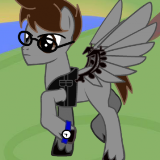Steam Locomotive ideas for my story. · 4:13pm Oct 23rd, 2013
Alright. Shimmering Honor and I were talking about the fanfic that im making. And we have a list of engines that will be introduced.
The list is as follows. (In no need order.)
GWR 14xx Class
LNER J50
LMS 2-6-2 Tank
GWR 57xx Class
LNER B17
LNER A3
LNER A4-Only one will be built
GWR 'City' Class
GWR 'Duke' Class
GWR 'Dean Goods' Class
American 2-10-0 'Decapod'
American 2-8-2 Mikado
-----------------------------------------------------
That's the list so far. But I want some engines to be named. So any ideas for names for some of the engines? And are there any other engines you would like to see? Must be American or British engines. Also, you must give me the engine class, and what railway they were from.



I think that will be plenty.
Southern Railways SR V/Schools Class and in keeping with the naming system it can be named after any school in equestria
Two problems.
1) The list is too long, and there are more than a few duplicates in there (at least for a story set in a short time-scale) - you really don't need both a City and a Duke - they were almost identical engines in practice, and that brings me on to the main thrust of my point:
Locomotive designers didn't actually design that many engines!
This fact is always skewed slightly by people like Sir Nigel Gresley who worked for thirty years as CME in a very large system made up of very different components with different requirements. William Stroudley, on the London, Brighton & South Coast Railway (LBSCR) believed he could manage with seven or eight different designs for his entire railway (and built twelve different designs in twenty years). Patrick Stirling, one of Gresley's predecessors on the Great Northern Railway (GNR) designed maybe ten basic outlines in a thirty year career at the top. Certainly Stirling produced many different subclasses - his 5'2" 0-6-0 tender locomotives might be considered to have anything up to a dozen subclasses, but they all had the same wheels, boiler and cab, meaning repair was greatly simplified. This brings me, conveniently, to my second point:
2) If you only have a few engines, you only have a few tricks for the drivers to learn, and for the fitters to remember. In other words:
Standardisation Wins!
Standardisation of parts - boilers, wheels, cabs, motion etc. - is always a Good Idea. At its simplest, it means that you don't have to devote as much storage space for spare parts - if all your wheels are the same, when an engine needs a light repair, most sheds will stock the part - if your tender wheels and carrying wheels under locomotives are all the same, you can store them in less space and also you don't actually have to store quite as many as you would otherwise - because the big works is always producing loads of them, any slight shortage can be quickly rectified, rather than when your Decapod breaks, the works having to drag a pattern out of storage to get you a new one - this also means less storage space required at the works. The other part is that it means your engines will be driven in the same way - rather than some being driven off the regulator and some the cut-off. It also means things like standardised cab layouts. Compare:
4.bp.blogspot.com/-edmXBpjSsmo/Tj_hDjngCGI/AAAAAAAABaA/VkfTY84VUtA/s1600/King_Cab.jpg
to:
lowres-picturecabinet.com.s3-eu-west-1.amazonaws.com/43/main/17/96079.jpg
IMHO you'd be better off trying to largely stick to one railway with a fairly tight policy of standardisation (at least initially), and go onwards and upwards from there - Stroudleys designs for the LBSCR would probably do well as a starting point for working out what engines you need; or Stirling's designs for the GNR (much more standard in many ways than so-called "Standard" ranges); or even the BR Standard range.
Sorry if this sounds like a hatchet job (and it sort of is sorry), but its a really good story idea, and considering my dislike of HiE, its done well to keep me. Its just that I'm applying for a Masters in Railway History, so this sort of thing is rather my special purpose. Ahem.
sorry), but its a really good story idea, and considering my dislike of HiE, its done well to keep me. Its just that I'm applying for a Masters in Railway History, so this sort of thing is rather my special purpose. Ahem.
P.S. You're going to need more than one A4. Classes of one are never economic, and always spend too long out of service due to unique parts being needed. And whilst the A4 was very reliable indeed (if you gave a homebrew class in this story the same sort of reliability that the Silver Link showed, I'd write you another essay like this one ). The LNER thought four was enough, and they seemed to be quite right in this regard.
). The LNER thought four was enough, and they seemed to be quite right in this regard.
P.P.S. If you have four A4's, there are four Princesses to shamelessly suck up to... that is to say "Show our loyalty and humble appreciation of"
An LNER Peppercorn A2 would sound interesting.
6g.nwrail.org.uk/julyaj0003.jpg